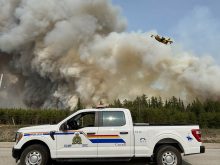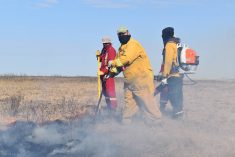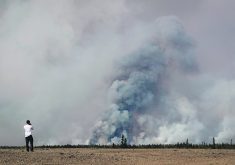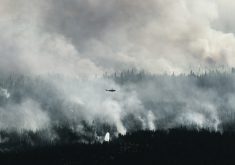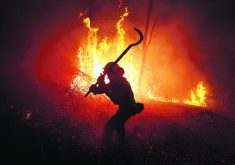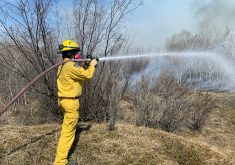FireSmart program intended to help landowners increase property’s resilience to wildfire and minimize negative impacts
For years, rangeland and forest managers have tried to eliminate aspen regrowth and encroachment on grazing lands or managed conifer forests with mixed success. But with all the wildfire outbreaks across Canada this year, the humble aspen tree could play a role in reducing the intensity of future wildfires in grazing and forested areas.
As part of the FireSmart program, a national wildfire prevention program, (www.firesmartcanada.ca) Wade Colwell and Blake Christianson with Alberta Forestry and Parks in Rocky Mountain House, Alta., designed and implemented a large landscape scale fuel break in 2012 that involved the removal of 330 hectares of pine and spruce forest to the west of the Fish and Goldeye lakes, near Nordegg, Alta.
The area had heavy coniferous tree cover with 20 percent dead trees, creating an increased potential of future large-scale catastrophic wildfires. Due to the location, prescribed burning as a means of reducing potential fuel load was not possible and mechanical mitigation was the only possible solution of reducing the wildfire threat potential.
The intent of the fuel break was to provide a defensible space for emergency personnel and equipment in the event of a large-scale wildfire to the surrounding area.
The goal of the FireSmart program is to help people increase their property’s resilience to wildfire and minimize its negative impacts. FireSmart teaches how to mitigate the risks and lower the impact of wildfires.
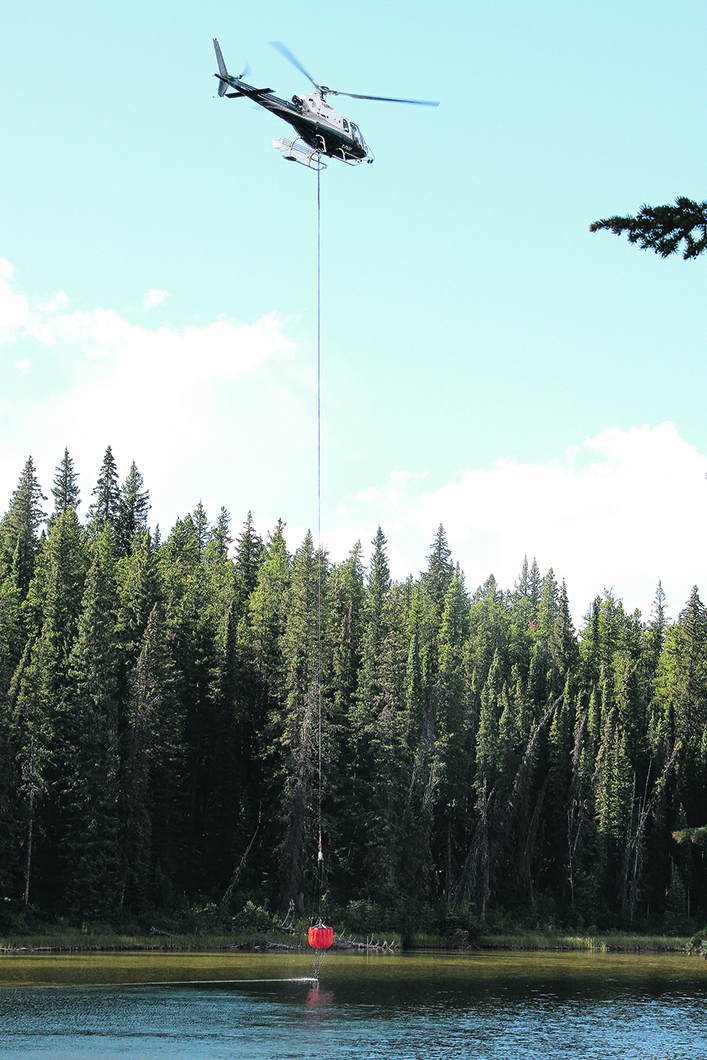
In a wildfire situation, heavy coniferous tree stands can burn quickly, whereas aspen trees usually burn at a slower rate and usually on the surface, which is more helpful for emergency response personnel. Thus, replanting an area to aspen trees has the future potential of reducing the effect of wildfires in the area.
“During the consultation for the project, we asked the local stakeholders what they foresaw as a potential value-added benefit to the area from the FireSmart treatment. They identified a need for more non-motorized trails,” said Colwell.
“This unanimous desire for more non-motorized trails would not only lead to the development of a unique 20-kilometre hiking trail system, but later became a great example of a wildfire prevention program using planted aspen trees.”
The area to the west of Nordegg is part of the R11 Forest Management Unit, commonly known as the Bighorn Backcountry. There are no large timber commitments here, and a small amount of oil and gas development.
As the timber in the area remains unallocated, Alberta Forestry and Parks is charged with the development of a forest management plan, including what areas are to regenerate naturally or be planted. The initial strategy for reforestation following the establishment of the fuel break under the FireSmart program was to leave it to regenerate naturally, meaning that trees and other plants are thought to regenerate on their own.

However, Colwell said after a couple years, 60 percent of the treatment area lacked tree regeneration and native grasses established, which created a secondary fire hazard because of the grass’s dry and slow decomposing litter.
“We had anticipated this problem prior to the treatment and the initial plan was to utilize the trail network as an anchor point from which we could use prescribed fire to remove the dry grass fuels early in the spring.
“However, a grass-dominated system would need repeated fuel removal treatments and therefore we explored the idea whether a tree species conversion from conifer to deciduous broadleaf trees could be a solution to limit grass development by blocking the sunlight and providing a less flammable fuel as tree cover. Since this was a conifer-dominated site, very few broadleaf trees such as birch, balsam poplar and aspen were present on the site. So, the only way this could be accomplished was through planting of these trees, restoring tree cover and potentially increasing the biodiversity and aesthetics of the area,” said Colwell.
Then Simon Landhausser, a forest ecologist from the University of Alberta became involved. And they applied similar procedures used for regenerating northern forest sites after industrial disturbance, such as mining areas around Fort McMurray.
“Trembling aspen is a resilient species that can regenerate from seed or from sprouts that develop from the root system after soil disturbance. If aspen suckers from its root system, it will result in many genetically identical trees or ramets. Ramets of one tree are called a clone. Aspen is one of the world’s largest living organisms. A single clone of aspen in Utah covers over 40 hectares and comprises 45,000 aspen trees that originated from a single tree many thousands of years ago.
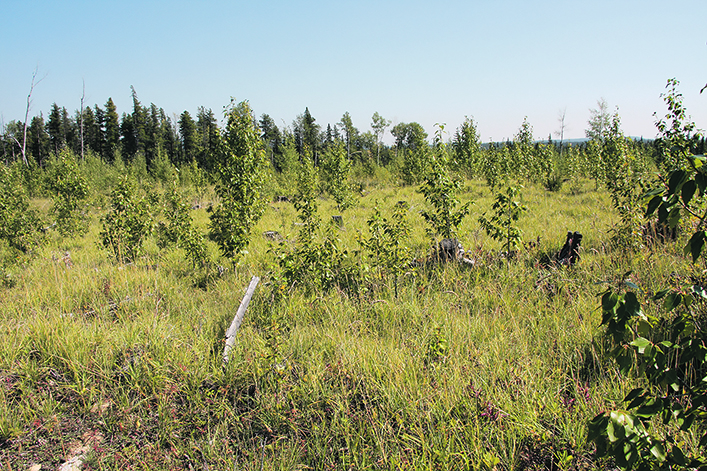
“However, with no aspen naturally present on the site, we could not use its suckering ability to increase the number of trees in the area and so we had to collect seeds to grow aspen seedlings commercially for this area. Based on provincially regulated seed collection rules, we identified different aspen mother trees for genetic diversity in the spring of 2016. They had to be at a similar elevation and ecological zone as our site where we wanted to plant the seedlings. In addition, the selected trees had to be a set minimum distance apart. To make things more complicated, there are male and female aspen trees and seed dispersal can happen very quickly, providing only a three-day window for seed collection. A single seed pod can produce six to 10 seeds and a group of seed pods called a catkin can have 20 to 40 pods. We were able to extract some 800,000 seeds from our 10 aspen seed trees. Sometimes we were able to pick the catkins from low-hanging branches of trees but other times we had to fire a shotgun into the upper branches and let the catkins fall to the ground. We wrapped the catkins in burlap and kept them cool in ice containers and brought them to the Smoky Lake, Alta., tree nursery where the nursery grew seedlings for us. It is also interesting to note that the seeds were still viable after five years when kept in frozen conditions,” said Colwell.
In the spring of 2017, Alberta Forestry and Parks planted 82,000 aspen seedlings at different locations along the trail system. Prior to planting, the grass and upper soil layer had been scarified using four different disturbance methods to give the seedlings a better chance to establish. Early results indicated that ripping the soil with a pronged tooth on an excavator disturbed the soil the best and resulted in good seedling establishment.
In a follow-up study, they explored whether planting aspen in different arrangements had any effect on early establishment success and the time it takes for aspen saplings to achieve crown canopy closure to block the sunlight from the grass.
For that, aspen was planted in clumps varying in size ranging from 35 to 2500 sq. metres and seedling density of 1,500 to 10,000 seedlings per hectare. They wanted to determine what was the quickest way to get crown closure and create the best edge effect in promoting future natural suckering to fill in the areas between the planted areas. The goal over time is to have the unplanted areas between plots become reforested through the suckering of the aspen when disturbed, which could lead to an unevenly aged and heterogeneous forest, potentially creating greater biodiversity and resiliency. Over the past seven years Alberta Forestry and Parks has established 400 permanent sample plots within the area to track the effects of tree density, clump size and scarification methods on aspen growth and mortality and future vegetation development.
“In the fall, you can now see different clumps of golden aspen trees throughout the treatment areas with the green conifer forest as the surrounding forested backdrop,” said Colwell.
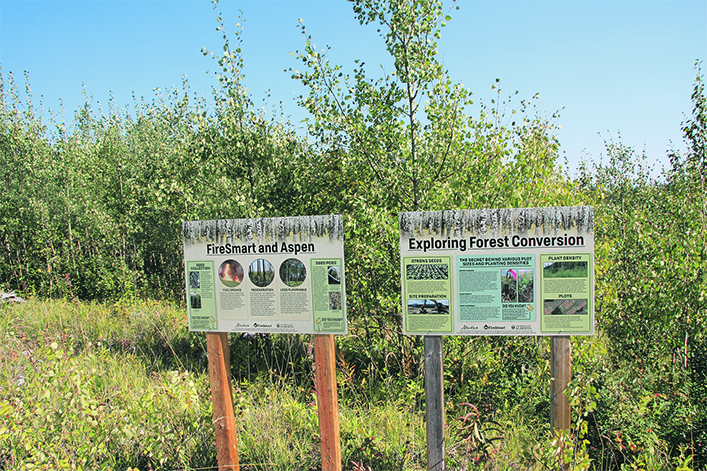
“Our goal is to create an educational area where people could look and see aspen regeneration in a recreational context as there are lots of people hiking the area from the Goldeye Lake and Fish Lake Provincial Recreation Areas. In addition, it created an area with reduced wildfire risk potential to the surrounding area, “said Colwell.
Landhausser is concerned about the continuing attitude of land and forest managers that aspen is a nuisance or weed that needs to be controlled.
“Forest policy makers and the public in general need to realize the benefits of aspen on the landscape, as it is one of the most resilient species that we have naturally occurring in Alberta and that once established can recover quickly after fire and other disturbances. This resiliency becomes even more important when disturbances occur over shorter intervals as is predicted under a new climate regime. Additionally, in other areas private landowners in particular should be rewarded financially for keeping treed and forested areas on their land, as existing and established forest do not require the energy and effort of planting forests from scratch, which is clearly not an easy undertaking as this and other studies demonstrates,” said Landhausser.





